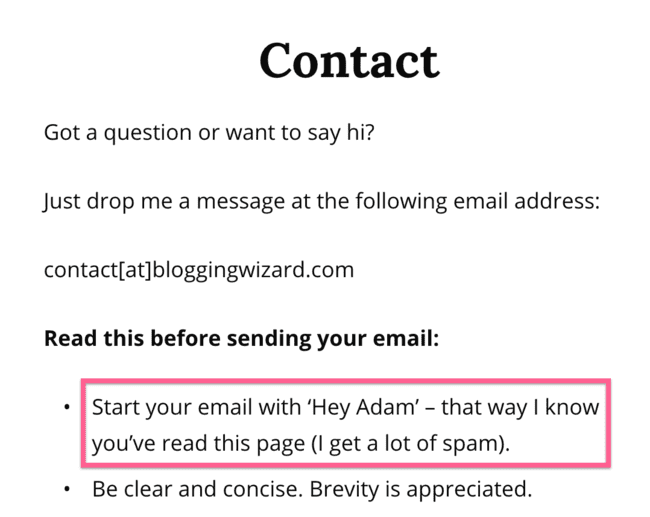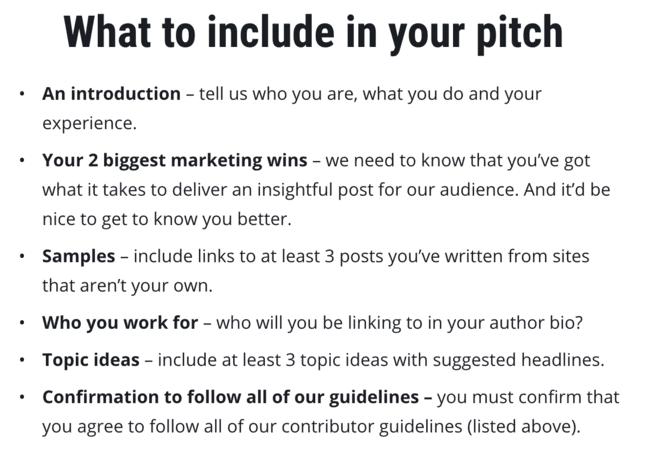The 2 Approaches I Use To Vet Guest Bloggers (And Stop Wasting Time)

Do you want to scale up content output without writing more content yourself? And at the same time, increase your traffic?
Accepting guest contributors is a great way to do this. You get free content, and the guest blogger gets traffic and exposure to a new audience.
And the blog post will benefit from two people promoting it, instead of just one.
If the guest blogger has a well-optimized sales funnel in place, that author byline traffic will translate into revenue. That’s how Daniel Ndukwu made over $1,800 for writing one guest post on Blogging Wizard.
So, it’s a win-win for both sides.
Now, sifting through all those spammy guest post pitches gets old fast. There are definitely some diamonds in the rough, but how are you supposed to find them?
And how can you save time when sifting through those pitches?
In this post, I’ll show you exactly how – so you can stop wasting so much time vetting potential guest contributors.
Let’s get started:
2 smart ways to vet potential guest bloggers
Most guest post pitches you’ll receive will be sent at scale. The people sending these pitches will use made up marketing persona’s and the content could be written by anybody – these are the ones that are usually a bad idea to publish.
Sometimes these will be easy to spot. Like the pitches I’ll get where the person wants me to publish a post about hunting knives on my marketing blog (lol).
But, other times the pitches will be extremely well worded – they’ll appear to tick all the boxes. And they’ll seem like they could be worth pursuing, that is, until they deliver a 500 word garbage article.
Or, they deliver an article with potential that you spend your time reading and sending over feedback for, but they never reply.
Then there will be those “diamonds in the rough,” where you’ll get an article you’d love to publish and help with promotion which will lead to expanding your audience.
So, now, I’ll share a few ways to qualify these types of pitches, so you don’t waste anytime that you can’t get back. I’ve been testing these approaches on a few of my sites and the results have been great.
Approach 1 – The quick qualifier
This is a simple approach that I’ve been testing out here at Blogging Wizard.
And when I say simple, I mean ridiculously simple – I add a quick qualifying statement that immediately lets me know that people have read my contact page.
Here’s an example of my contact page at the time of writing this:

So, here, I’m asking people to just include “Hey Adam” at the beginning of their email. It’s entirely possible that some people will just do that naturally, so I could do with improving this.
Although, I needed something more general to account for other types of outreach, not just guest post pitches. What matters is that these two words have saved me a heck of a lot of time.
And, because I specify which email address to contact me on, it also makes it clearer when people have used tools to guess my other email addresses.
This approach is simple and takes a few seconds to implement.
Although, granted, I do periodically stop accepting guest posts on Blogging Wizard. When this happens, I’ll update my contact page because it stops people wasting their time, and it acts as an additional qualifier.
Here’s why this works:
Most people doing guest blogging at scale (as in, using automated tools to send emails), will rarely pay attention to anything that’s written on a contact page.
So, you’ll be able to spot when people take the time to read your contact page.
Approach 2 – The TMI qualifier
This is the method that I use on Startup Bonsai.
The idea is that you get potential guest bloggers to deselect themselves from the process before they’ve even reached out, and set high standards for the content you’re looking to publish at the same time.
I wrote up a detailed set of contributor guidelines. This sets expectations right out of the gate, and I drop various “deselectors” throughout the page.
For example, I state that posts must be at least 2,000 words. Anyone reading the page that isn’t prepared to write that much content will jump ship at that point.
Here’s the thing:
This method is designed to help both the blogger/editor and the guest blogger. It helps everyone get on the same page and nobody wastes time they don’t have.
The page consists of 4 main parts:
- Our audience
- Contributor guidelines
- What to include in your pitch
- Where to send your pitch
The first two sections are mainly geared to set expectations of content standards/quality but the last two sections are the real “qualifiers.” So, let’s break it down:
The “what to include in your pitch section:

In this section, I ask for all of the information I’ll need to ensure a potential contributor is a good fit for the site. I’m protective over my audience and the content we publish impacts the sites reputation.
The part about “Who you work for” is important. Here, I’m encouraging people to be transparent about who they work for.
In the past, I’ve had an issue with guest bloggers that only reveal who they work for at the very last moment. And sometimes that company may turn out to be something shady or unethical (I’m looking at you, essay writing companies!)
The “where to send your pitch” section:
This section is super simple. I give contributors an email address to use and a specific subject line that says “I want to write for Startup Bonsai.”
This is a similar thing to the quick qualifier method I use on Blogging Wizard but specifically focused around those wanting to write for Startup Bonsai.
Combined with the previous section, this is sort of a combination lock to getting through the door (so to speak).
There will be those that will scroll to the bottom of the page, throw “I want to write for Startup Bonsai” in the subject line, and ignore the rest – this makes it obvious when someone hasn’t fully followed the guidelines.
Here’s why this works:
Rather than having to hunt around for information to vet guest bloggers, you get everything you need to know in one email. That, or they haven’t read the page, in which case, you know what you need to do!
The contributor guidelines means everyone knows the score, which helps avoid issues and saves time during the editing process. And it saves the time of those that pitch us too.
Ultimately, this is a huge time saver all round! It’ll stop your inbox getting flooded with so many pitches, and those you do get through will likely be from people whose content will be a great fit for your audience.
And once a guest blogger delivers that finished article, you’ll immediately be able to tell whether your guidelines have been followed.
Which approach should you use?
If you’re pressed for time, go for the “quick qualifier” approach. It’s simple and saves a surprising amount of time – those few words make a significant difference.
This will give you the opportunity to test the waters and monitor the impact on the volume/quality of pitches you receive.
But, you may find that you’ll get more mileage out of the “TMI qualifier” approach. While you’ll need to spend more time developing your contributor page, you’ll save the most time in the long-run.
And there are key benefits of this approach:
- You’ll get a lot less pitches (great if you’re always flooded with emails).
- Either, you’ll get everything you need to vet a new contributor in their pitch, or you’ll know they haven’t read the page.
- Writers will know where they stand because your guidelines are public.
- The content you get at the end will usually be of a much higher quality.
I’ve been testing these side-by-side for a while now, and the “TMI qualifier” approach is by far the best. But, regardless of which you choose, using one of these approaches is better than using none of them.
Putting it all together
Part of the reason for taking these approaches is to safeguard my time. There’s not much of it and I’d rather spend my time on developing useful content for you.
But, another part of this is because I want to ensure I’m delivering the best content for you that I can. Whether it be from me or another author – what we publish matters.
I can also see this from the side of the guest blogger too. Giving up time to write free content for someone else is a big deal.
So, following the “TMI qualifier” approach has the additional benefit of setting expectations upfront.
Now, if you’re pushed for time and just want a quick and easy way to qualify guest contributors, try the “quick qualifier” method. But, ultimately, you’ll get more mileage from creating a “Write For Us” page like the one I created for Startup Bonsai.
And if you want to step things up a gear, you can always find other bloggers that you can invite to become a guest blogger.

